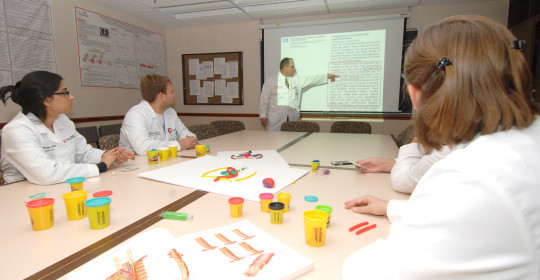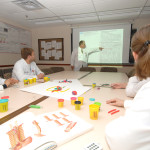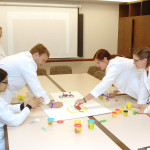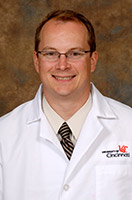
New Physicians Becoming Outstanding Teachers
The University of Cincinnati Medical Center Division of Pulmonary, Critical Care, and Sleep Medicine Innovative Fellowship Education Program is helping new physicians become outstanding teachers.
An interactive, participatory learning modality is quickly becoming the standard for large group presentations of medical information, gradually replacing the more traditional, passive didactic approach.1 The University of Cincinnati Medical Center Division of Pulmonary, Critical Care, and Sleep Medicine has embraced this new method; in addition to use of advanced interactive technologies such as the audience response system (ARS) Turning Point by the educator, direct involvement of the audience participant fosters a positive educational environment, says Peter Lenz, MD, MEd, associate fellowship director for Pulmonary and Critical Care Medicine.

Dr. Peter Lenz instructs new pulmonary critical care fellows during their boot camp to prepare them for procedures and critical care services. From the left, fellows Dr. Mandeep Grewal, Dr. Michael Hellmann, and Dr. Karen Niehaus enter their answer to a bronchoscopy sedation question and Lenz can adjust his amount of teaching to the audience based on the responses the fellows entered anonymously into the ARS (audience response system). Pictured here is a synopsis slide Lenz reviews after seeing the results from the fellows on the previous slide.

This type of non-threatening learning environment allows for “contingent teaching” by giving authority for the pace of instruction over to the audience. Pictured also on the table is a set of Play-Doh used by the new fellows to construct the mediastinum. Interactive learning that incorporates team-based construction teaches detailed lessons about anatomy that will be used in upcoming procedures.
Lenz explains, “We evaluate the lectures that our fellows give, using the concepts of adult learning theory and learner engagement. When giving scientific presentations, we ensure our fellows have optimized slide design for clarity and present their data in accordance with the Accreditation Council for Graduate Medical Education (ACGME) milestones.” By rating both the fellows’ clinical knowledge and their facility with imparting that knowledge in an engaging manner, senior physicians are helping create a generation of more effective educators.
Lenz and the University of Cincinnati Medical Center first received national recognition in 2012 in the form of the Darlene Buczak Award for Educational Excellence from the Association of Pulmonary and Critical Care Program Directors. This award recognizes training program directors for their contributions to medical education.3 Recently, the American Thoracic Society (ATS) named the University of Cincinnati Medical Center a Top 6 Fellowship Education Program, citing its innovative board review program in which small groups of fellows actively develop board review-style questions based on their own clinical experience and observations. The ATS recognition led to a presentation at the ATS annual conference, followed by an article written for the Annals of the American Thoracic Society this year. These interactive learning modalities are certainly applicable to specialties beyond pulmonology, and are also highly effective with residents and medical students.
To foster a culture of hands-on clinical training as well as interactive learning opportunities, the faculty developed a “Mini Boot Camp” for new fellows. This program, co-directed by Lenz and Renee Hebbeler-Clark, MD, was designed to build skills and facilitate patient safety before new fellows perform the first procedures of their fellowship. The Mini Boot Camp partnered with the university’s Air Force Center for Sustainment of Trauma and Readiness Skills (C-STARS) to gain access to cadavers and state of the art simulation resources. Lenz emphasizes that the intensive fellowship education program succeeds largely because of the extremely collaborative culture both within the University of Cincinnati Medical Center and with other pulmonary and critical care fellowship program directors who conduct “Boot Camp” programs around the country.
References: 1. Lenz PH, McCallister JW, Luks AM, Le TT, and Fessler HE. Practical Strategies for Effective Lectures. Ann Am Thorac Soc April 2015, 12;4:561–566. 2. http://www.apccmpd.org/darlene-buczak-award. Accessed June 12, 2015.
 Peter Lenz, MD
Peter Lenz, MD
Assistant Professor of Medicine
Associate Fellowship Director for Pulmonary & Critical Care Medicine
(513) 558-0191
lenzpr@ucmail.uc.edu

